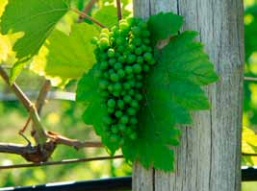
Monterey County produces so many outstanding red wine varietals, which admittedly leads to less attention devoted to our County’s white wines. And, it is attention that is well-deserved. Monterey County produces equally outstanding whites as it does red wines.
You know this is true for our Chardonnays. Throughout California, the country, and even globally, Monterey County Chardonnays are recognized. Our wonderful Pinot Noirs often receive the flashy headlines, but our Chardonnays may be arguably easier to find in wine stores. In fact, at the same time that wine region northeast of the Bay Area became famous for its Cabernet Sauvignons, Monterey County’s Chardonnay potential was revealed to the world.
Just as Monterey County’s unique climate and growing conditions offer a wide diversity in agricultural produce, the same is true for grape varietals. And we have more than Chardonnay. In previous articles we’ve discussed how Riesling has long been considered one of the County’s top other white varietals, and we’ve spent time with Sauvignon Blanc and the growing popularity of white Rhône varietals. Now it’s time to take a look at yet another white varietal we have the pleasure of offering: Pinot Blanc.
 True, Pinot Blanc is not one of our most popular white varietals. However, growers and winemakers have been producing topnotch Pinot Blanc wines for years in Monterey County. Chalone Vineyards was likely the first winery to produce Monterey County Pinot Blanc wines as they have some of the oldest grape vines True, Pinot Blanc is not one of our most popular white varietals. However, growers and winemakers have been producing topnotch Pinot Blanc wines for years in Monterey County. Chalone Vineyards was likely the first winery to produce Monterey County Pinot Blanc wines as they have some of the oldest grape vines
in the County in the Chalone AVA, including Pinot Blanc vines. To this day, Chalone continues to produce excellent Monterey County Pinot Blanc wines, but they are not alone. J. Lohr, Chock Rock, Bargetto, La Rochelle, Silvestri, and Cima Collina all offer premium Monterey County Pinot Blancs as well. We’ve included an excellent example of Monterey County’s Pinot Blanc potential with the Cima Collina Pinot Blanc we’ve included in this month’s Wine Club selection.
Now that you know the background, let’s take a closer look at this lesser-known white varietal. To answer that initial question – yes, the varietal is related to Pinot Noir. It’s actually a genetic mutation of Pinot Noir, and an infamously unstable mutation. So unstable in fact that at times an entire vine can unexpectedly turn from a light green color to a dark blue.
In addition to the potential for a complete fruit color transformation to occur, Pinot Blanc is not the easiest varietal to grow, similar to its red varietal cousin. It is not a varietal which can be grown, much less grown well, anywhere and requires stringent climate and soil conditions to truly present its best characteristics.
Pinot Blanc is made into primarily dry wines here in California and is also produced as dry whites in France’s Alsace region (where it is also used for sparkling wine as well), Germany, Italy (where it is known as Pinot Bianco), and Hungary. In Canada the varietal is used for ice wine production. Here in Monterey County, expect the best of dry Pinot Blanc whites wines to be fully showcased. These are full-bodied white wines, with deep aromas of stone fruits, light citrus, and floral characteristics. Pinot Blanc wines often have a creamy texture, but our Pinot Blancs tend to be more rich in minerality, producing crisper wines.
Pinot Blanc wines tend to be high in acidity, so keep this in mind when considering potential food pairings. The varietal’s characteristics make it a good option for cheese pairing or to match with light chicken or fish pasta dishes. Pinot Blanc’s origins are murky, but it’s accepted as having found its place in the viticultural world in France’s Alsace region. Escargots (snails) are popular in this region of France, and not so surprisingly Pinot Blanc-based wines are favorites to accompany these land crawling mollusks.
In years past, Pinot Blanc was referred to by some as the “poor man’s Chardonnay.” Why this was the case – I honestly have no idea. When I think of Pinot Blanc compared to Chardonnay wines all I see as similar is that they are both dry white wines which somehow originated in France. It is true, however, that the two varietals do often share similar winemaking styles including barrel aging, use of oak, and malolactic fermentation…but the similarities really stop there. And the reference to a “poor man’s wine” would seemingly indicate a lesser quality wine, which is definitely not true.
As with most white wines, Pinot Blanc wines are not meant for aging. So whether you open your new Monterey County Pinot Blanc bottle with snails or not, we recommend you open it soon to discover yourself this varietal’s uniqueness and difference from Chardonnay. |